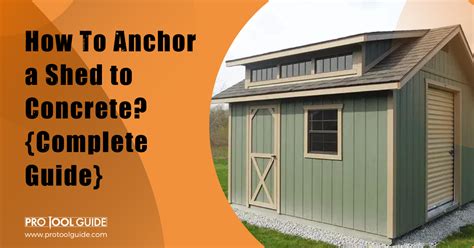How to Choose the Right Concrete for Shed Anchoring
Building a sturdy shed requires a solid foundation, and that often means anchoring it with concrete. Choosing the right type of concrete is crucial for ensuring your shed remains stable and secure for years to come, regardless of weather conditions or shifting ground. This guide will walk you through the key considerations when selecting concrete for shed anchoring.
What Factors Influence Concrete Choice for Shed Anchors?
Several factors play a significant role in determining the appropriate concrete mix for your shed's anchoring needs. These include:
- Shed Size and Weight: Larger, heavier sheds necessitate stronger, more durable concrete mixes. A small garden shed will have different anchoring requirements than a large workshop.
- Soil Type: The type of soil beneath your shed significantly impacts the concrete's needed strength. Loose, sandy soil requires a higher-strength concrete mix compared to firm clay soil.
- Climate: Extreme temperature fluctuations and freeze-thaw cycles can affect the concrete's longevity. In colder climates, consider a mix designed for freeze-thaw resistance.
- Anchor Type: The type of anchor you're using (e.g., ground screws, concrete piers, rebar) will also influence the necessary concrete properties.
What Type of Concrete is Best for Shed Anchoring?
While pre-mixed bags from home improvement stores are convenient, understanding the components of concrete allows for a more tailored approach. The key components are:
- Cement: This is the binding agent that holds the concrete together. Portland cement is the most common type.
- Aggregates: These are the inert materials like sand and gravel that provide bulk and strength. The size and type of aggregate influence the overall strength and workability of the concrete.
- Water: Water activates the cement, initiating the chemical reaction that leads to hardening. The water-cement ratio is critical for achieving the desired strength.
For shed anchoring, you generally want a concrete mix with a high compressive strength. This is often expressed as a psi (pounds per square inch) rating. A higher psi rating indicates greater strength and durability. A minimum of 3000 psi is generally recommended, but for larger or heavier sheds, a 4000 psi mix or higher might be necessary.
You can achieve this higher strength either by buying a pre-mixed bag with a high psi rating or by carefully choosing the proportions of cement, aggregates, and water when mixing your own. If mixing your own, consider consulting a concrete professional or using a concrete calculator to determine the correct ratios for your needs.
How Much Concrete Do I Need?
The amount of concrete needed depends on the size and number of anchors. You'll need to calculate the volume of each anchor hole, considering the anchor's dimensions and the depth of the hole. Always add extra concrete to account for potential settling and waste.
What are Some Common Mistakes to Avoid When Using Concrete for Shed Anchoring?
- Using the wrong mix: Using a low-strength concrete mix can lead to instability and failure.
- Not properly preparing the hole: The hole needs to be dug to the appropriate depth and width to ensure proper support. Loose soil should be compacted before pouring the concrete.
- Not allowing sufficient curing time: Concrete needs time to properly harden. Avoid placing weight on the anchors until the concrete has fully cured, typically 28 days.
- Ignoring weather conditions: Extreme heat or cold can affect the curing process. Take necessary precautions to protect the concrete during curing.
How Do I Choose Between Pre-Mixed Concrete and Mixing My Own?
Pre-mixed concrete is convenient and readily available, but it may be more expensive and less customizable in terms of strength. Mixing your own concrete offers more control over the mix design, potentially leading to a higher-strength concrete at a lower cost, but requires more time and effort.
What Kind of Concrete Should I Use for a Metal Shed?
The concrete requirements for a metal shed are essentially the same as for a wooden shed. The weight and size of the shed are the primary determinants of the necessary concrete strength. Focus on the shed's overall weight and the soil conditions to choose the appropriate concrete mix.
What are the Best Practices for Anchoring a Shed to Concrete?
Ensure the anchors are properly embedded in the concrete and that the concrete is fully cured before attaching the shed. Follow the manufacturer's instructions for your specific anchor type. Consider using expansion anchors or other specialized fasteners for extra security.
By carefully considering these factors and choosing the right concrete mix for your specific needs, you can ensure your shed remains firmly anchored and provides years of reliable service. Remember, investing in high-quality concrete is a worthwhile investment in the longevity and stability of your shed.

